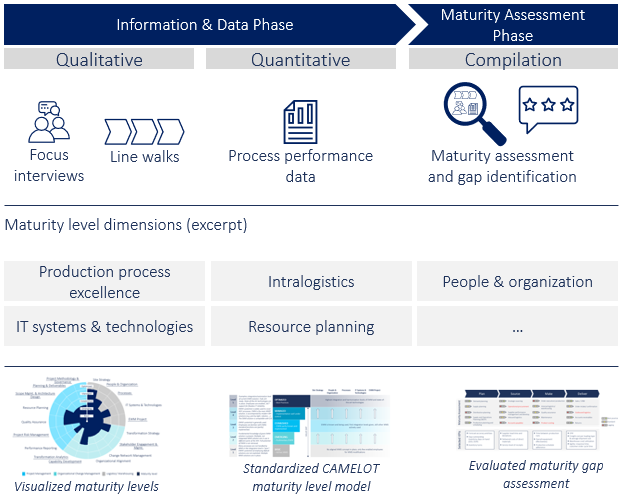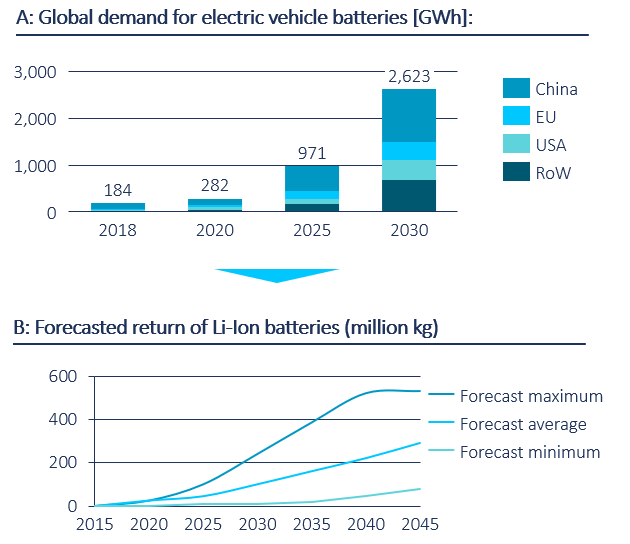In our last blog post we addressed the opportunities of circular economy strategies and reuse strategies for the e-mobility sector. The following article focuses on remanufacturing as a key element of a circular economy. The first section explains the term “remanufacturing” more precisely. Then we focus on the added value for the customer, as well as for the producers of the remanufactured product. We discuss the necessary prerequisites for the successful implementation of remanufacturing within the company before we move to an illustration of the entire process in the last section, using electric vehicle batteries as an example.
What Does “Remanufacturing” Mean?
Remanufacturing is a process of extensive refurbishing used, but usually not defective, products to restore them to the quality standards of a new product. To this end, the product in most cases is partially or completely disassembled in order to inspect the components and/or sub-assemblies. The product could possibly undergo technological upgrading if defective components need replacing. As a rule, remanufacturing is used to extend service life, for example in wind turbines. Remanufacturing is different from repair, reuse or refurbishing:
- The starting point for a repair is a defective product, which is restored to a functional condition.
- The reuse of products follows the principle of avoiding the disposal process by using a product or item elsewhere, and if necessary for a different purpose.
- Refurbishing refers to the quality-assured repair of products with aim of reuse and usually takes place much earlier in the life cycle than remanufacturing. This is generally done with non-defective products. Products returned after the 14-day right of cancellation, for example, are in most cases inspected and then sold as “refurbished”. This process is especially common in the case of IT and office equipment.
What all strategies have in common is that they help to prevent waste and to conserve primary resources.
Advantages and added value for customer and producer
Remanufacturing offers advantages and adds value on both the customer’s and the manufacturer’s side.
 Figure 1: Overview of added value for customers and manufacturers through remanufacturing
Figure 1: Overview of added value for customers and manufacturers through remanufacturing
Potential for the manufacturer:
- lower production costs in comparison with a new product
- new source of revenue from after-sales activities
- better quality of remanufactured products thanks to improved spare parts
- reduced energy consumption, reduced resource consumption
Potential for the customer:
- lower price barrier
- better quality of the remanufactured products
- better after-sales-service
- increased sustainability
- use of state-of-the-art technologies
The prerequisites for successfully establishing remanufacturing in a company are explained below.
Prerequisites for the Successful Use of Remanufacturing
Efficient remanufacturing is based on three key elements:
- Product: Remanufacturing aspects must be taken into account, even in the early stages of product development. This affects, for example, the materials selected, or the design methods used. The design and construction of the products plays a key role regarding the disassembly and refurbishing of parts . This aspect is summarized under the keyword “design for remanufacturing”.
- Reverse supply chain: The starting point, and the most important input into the remanufacturing process, is the recovery of the used products. Strategic partnerships can be formed to return products into the supply chain, for instance with players who are at the end of the value chain.
- Business model: The business model behind remanufacturing must contribute to the overall corporate strategy. Examples worth mentioning here include margin improvement, cost optimization, and increased sustainability in the company, or reduction of the CO2
In order to successfully implement the three key elements described, each potential component or product must be examined in its specific context. This means: Dedicated consideration must be given to materials, specifications, manufacturing methods, the market, the life cycle, the supply chain, and customer requirements, as well as the technical background. Based on the results of this, a remanufacturing strategy and roadmap can be derived for suitable products.
It is usually helpful to determine the status quo, as a baseline for a comparison with the perceived goal. This can be achieved with a remanufacturing maturity analysis as shown in figure 2. The maturity analysis is divided into an information phase and an evaluation phase. In the first phase, input for the assessment is gathered via interviews, line walks and process performance data. Subsequently, a multi-dimensional analysis evaluates the maturity level of the company with regard to the remanufacturing process. The production process, intralogistics, needed IT systems and supply chain planning processes are among the dimensions that must be evaluated. All dimensions count towards the above-mentioned key elements (product, reverse supply chain and business model).
 Figure 2: CAMELOT approach to determining remanufacturing maturity
Figure 2: CAMELOT approach to determining remanufacturing maturity
Remanufacturing of Electric Vehicle Batteries as an Attractive Business Model
Electric vehicle batteries are very well suited for consideration in the context of remanufacturing because the demand for these batteries will continue to grow in the coming years due to limited quantities of raw materials and rising raw materials prices. Also, the volume of used batteries will increase, providing more input for the remanufacturing process. Subsidies, such as e.g., the recently extended purchase premium for electric cars in Germany serve to further strengthen this trend. Figure 3 illustrates the requirements and the expected returns.
 Figure 3:
Figure 3:
A Expected global demand for electric vehicle batteries [GWh] [1];
B: Predicted returns of electric vehicle batteries [million kg] [3]
The expansion in remanufacturing electric vehicle batteries will lead to a drop in the production cost per KWh for batteries. For those active in battery remanufacturing, this will result in an increasing margin, or the opportunity to generate market share thanks to lower prices.
Most common battery designs
To evaluate the remanufacturing potential of battery cells, and to be able to design the necessary process appropriately, one needs to understand the building principles of the most common types of vehicle batteries:
- cell module pack
- cell-to-pack
- cell-to-chassis
The majority of electric vehicles are currently equipped with a battery that contains a battery pack consisting of several battery modules; called the cell module pack. The battery modules themselves are assembled from several battery cells connected in series (see figure 4 top row, cell module pack). Combining them into battery modules delivers a high battery safety. This is why this design is currently used as standard, even if the possible energy density is lower than in other building patterns.
With the second discussed building principle, the cell-to-pack technology, large individual cells are used, which are directly interconnected to form a battery pack (see figure 4, middle row). The advantage of this still fairly new design is that the energy density can be increased by 10 to 15 percent.
In order to achieve even higher energy densities than this, the brand new cell-to-chassis technology is currently being promoted (see. Fig. 4, bottom row). Here, the battery pack is directly integrated into the vehicle chassis. In terms of remanufacturing, we assume that this design will increase disassembly-related challenges.
Figure 4 illustrates the construction methods described above schematically.
 Figure 4: Electric vehicle battery construction methods
Figure 4: Electric vehicle battery construction methods
In the following, we focus on remanufacturing processes for the first two variants. Rationale: Currently, cell-to-chassis design has not yet fully reached series production, and standard design and cell-to-pack strategy account for around 99% of the market.
The remanufacturing process of electric vehicle batteries: core elements
For both construction methods under consideration, the remanufacturing process can be broken down into six main steps.
- Battery diagnosis: Algorithms are used to check and categorize the delivered battery cells e.g. into the following categories:
a) end-of-Life,
b) Second-Life with possible reuse as home storage,
c) remanufacturing with reuse as an electric vehicle battery.
Audi launched the “BattMAN“4 project with this end in mind. - Disassembly: In the second step, the battery packs are disassembled, with a possible intermediate step of disassembling the battery modules, or directly at the level of cell disassembly, depending on the design.
- Cell testing: Next, the cells are subjected to a detailed check.
- Cell / module replacement: Cells that no longer provide the desired performance are replaced.
- Battery assembly: The tested cells and new cells are reassembled to form the reconditioned electric vehicle battery.
- Final quality control: The final quality check ensures that the reconditioned electric vehicle battery meets customer requirements.
The described process is illustrated schematically in Figure 5:
 Figure 5: Schematic process of battery remanufacturing based on [2]
Figure 5: Schematic process of battery remanufacturing based on [2]
Required Knowledge and Infrastructure for the Remanufacturing of Electric Vehicle Batteries
The process is based on certain prerequisites for successful implementation. These relate to the required know-how in the company (overall company and personnel) as well as the necessary infrastructure for delivery, storage, testing and remanufacturing.
Know-how
The know-how can be broken down into two sub-categories:
- Know-how related to the remanufacturing process: On the one hand, employees in the remanufacturing process must be trained in handling high-voltage batteries in order to be able to disassemble the battery cells. In addition, they should be familiar with construction methods and product specifications, in order to ensure an efficient disassembly.
- Chemical know-how: In addition to basic knowledge of production technology, skilled staff are needed who are trained in handling the chemicals used, especially liquid electrolyte, anode and cathode materials, and separators.
Infrastructure
In addition to building know-how, the infrastructural requirements must be created to handle the cells and ensure a seamless remanufacturing process. These include:
- incoming logistics infrastructure for battery transport,
- storage / processing area required (depending on throughput) as newly arrived batteries usually have to undergo a quarantine period to rule out transport or other damage which requires space,
- storage requirements for damaged and undamaged battery modules and packs must be met – preferably not far from the customer,
- access to chemical waste treatment facilities, and
- access to process water and nitrogen must be provided, and
- extensive logistics infrastructure is needed for inorganic chemicals and electrolyte solutions.
These prerequisites are core requirements.
Summary
The article explains the remanufacturing process of technical products using the example of electric vehicle batteries. To this end, we provided an outline on the added value for customers and producers, discussed the core process of remanufacturing, and described the necessary prerequisites in terms of know-how and infrastructure. Based on the content presented, interested parties can implement initial steps to identify remanufacturing potential in the company (e. g. identifying relevant products).
In our next post, we will look at electric battery ownership and data-driven business models for manufacturers/remanufacturers.
Sources
[1] Zhao et al. 2021 – A Review on Battery Market Trends, Second-Life, Reuse and Recycling
[2] Kampker et al. 2020 – Battery pack remanufacturing process up to cell level with sorting and repurposing of battery cells
[3] Statista
[4] Second life or recycling? BattMAN rescues batteries from a needlessly short lifespan
[5] Steinhilper & Weiland 2015 – Exploring New Horizons for Remanufacturing – An up-to-date Overview of Industries, Products and Technologies
This article is part of a series on the circular economy. Here is an introduction on circular economy.
We look forward to hearing from you if you would like to discuss your plans for reuse/second life and remanufacturing. Write to Jens Steuer (jste |at| camelot-mc.com).

